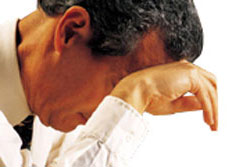- What is Headache
- Statistics on Headache
- Risk Factors for Headache
- Progression of Headache
- Symptoms of Headache
- Clinical Examination of Headache
- How is Headache Diagnosed?
- Prognosis of Headache
- How is Headache Treated?
- Headache References
What is Headache
Headache, the medical term for which is cephalgia, refers to diffuse head pain; that is, pain which is spread throughout the head and not restricted to areas in which the head’s nerves are located. It is amongst the most common causes of pain for which a person might visit their general practitioner. Traditionally headaches have been classified as either:
- Primary: Headaches with no apparent underlying cause; or
- Secondary: Headaches caused by a medical condition such as an infection or injury to the head.
Primary headaches
Primary headaches may be further classified as:
- Transformed migraine or chronic migraine, which may also be termed medication overuse or rebound headaches. These headaches typically occur as a result of overuse of medicines used to treat primary headache disorders, most commonly migraine;
- Migraine with or without aura, refers to recurring headaches characterised by unilateral (on one side), pulsating pain;
- Chronic tension-type headache is characterised by bilateral (on both side), pressing pain on 15 or more days per month;
- Cluster headaches characterised by unilateral head pain which occurs regularly for several weeks (a cluster of headaches), followed by a period in which no headaches are experienced;
- New daily persistent headache;
- Hemicrania continua (short lasting headaches characterised by unilateral pain);
- Idiopathic stabbing headache;
- Cold-stimulus headache;
- Benign exertional headache (occurs following exertion);
- Benign sex headache (acute head pain which typically occurs after every instance orgasm).
Secondary headaches
Secondary headaches are classified according to the onset, severity and frequency of head pain symptoms, as the nature of the symptoms indicate which secondary conditions may underpin the headache. This guides the diagnosing doctor in regard to which condition should be considered in the differential diagnosis. The headache pain may be classified as:
- Acute (sudden onset within minutes or hours);
- Sub-acute (gradual onset over hours or days);
- Recurrent; or
- Chronic.
Statistics on Headache

Chronic headaches are amongst the most common pain complaints in children and adolescents. Children who experience chronic headaches are most likely to be diagnosed with migraine or tension-type headache. Newly occurring headache disorders are most commonly diagnosed in childhood or between 20 and 50 years of age.
Secondary headaches
Incidence of secondary headache disorders depends on the incidence of conditions which underlie those headaches. For example, headaches occurring secondary to infections like meningitis are more common in areas where meningitis is more prevalent.
Primary headaches
A large study conducted in Switzerland reported that yearly prevalence of various types of primary headaches differed, and females were more affected than males (see table).
Table: Prevalence and incidence of primary headache types
| Primary headache type | 1-year prevalence | 30 cumulative incidence |
Male:female ratio |
| Migraine with aura | 0.9% | 3% | 1:2.8 |
| Migraine without aura | 10.9% | 36% | 1:2.2 |
| Tension type headache | 11.5% | 29.3% | 1:1.2 |
Another study reported chronic daily headaches affect 4% of the population, with equal numbers experiencing chronic migraine and chronic tension-type headache. However, the vast majority (80%) of severe cases of daily headache are due to chronic migraine.
Risk Factors for Headache
Primary headaches
Risk factors for primary headaches differ depending on headache type. Individuals who experience headaches during childhood are more likely to experience headaches as adults.
Migraines have a genetic component. Individuals with a family history of migraine are more likely to experience these headaches than those who do not have family members affected by migraine. Migraines are also associated with stress, mental tension and head trauma.
Chronic migraine/medication overuse headaches occur in individuals using pain medication for extended periods and are also associated with obesity.
Tension-type headaches occur in 47% of patients following acoustic neuroma surgery (surgery to remove a tumour on the nerve which connects the ear to the brain) and may also occur following head trauma. Other risk factors include stress, mental tension and, in males, a sedentary lifestyle.
Secondary headaches
The key risk factor for secondary headache is having a medical condition known to cause headache. A wide range of conditions are associated with secondary headaches including:
- Head trauma/injury;
- Vascular (blood vessel) disorders including:
- Sub-arachnoid haemorrhage (a type of stroke characterised by bleeding in the arachnoid membrane of the brain);
- Acute ischaemic cerebrovascular disease (a group of conditions characterised by lack of blood/oxygen flow to the brain);
- Unruptured vascular formation (abnormal blood vessels formations which have not ruptured to cause bleeding);
- Arteritis (inflammation of the arteries);
- Carotid artery pain (pain affecting the carotid artery of the brain);
- Vertebral artery pain (pain in the artery which connects the spine to the brain);
- Venous thrombosis (formation of a blood clot inside a vein);
- Arterial hypertension (high blood pressure in the arteries);
- Intracranial disorders (non-vascular) including:
- Benign intracranial hypertension (pseudotumour cerebri) (increased pressure in the brain);
- Intracranial infection (infection in the brain);
- Low cerebrospinal fluid level;
- Substance use (acute or chronic) or withdrawal;
- Non-cephalic infection (infection in body sites other than the head) including;
- Viral infection;
- Bacterial infection;
- Metabolic disorders including;
- Hypoxia (lack of oxygen supply);
- Hypercapnia (respiratory failure with elevated carbon dioxide pressure);
- Mixed hypoxia and hypercapnia;
- Hypoglycaemia (low blood sugar levels);
- Receiving dialysis;
- Metabolic abnormality;
- Disorders of the:
- Neuralgias (pain affecting the nerves).
Progression of Headache
The development of headaches differs depending on type. In secondary headaches onset may be sudden (e.g. with exertional headaches or those underpinned by bleeding in the brain) or gradual (e.g. those occurring secondary to inflammation of the arteries).
Primary headaches are typically recurrent; however the pattern of occurrence differs. For example, cluster headaches occur as clusters of frequent (often daily) headaches followed by an extended period in which no headaches are experienced. Other types of primary headaches occur constantly, without periods of remission. Duration of a headache may be as short as several minutes but they often persist for hours or days.
Symptoms of Headache

To determine the best course of treatment, the doctor must determine whether your symptoms are caused by primary or secondary headaches. Headaches which commenced at around the same time as a new illness or injury are likely to be diagnosed as secondary headaches. A secondary headache diagnosis will also be considered in individuals (including those who have previously been diagnosed with a primary headache type, for example migraine) whose headaches worsened around the time of illness or onset of injury. Initial questions the doctor may ask to help them distinguish between primary and secondary headaches may include:
- When did the headache begin?
- Was headache onset:
- Gradual?
- Sudden?
- Other?
- How often do you experience headaches?
- How many previous headaches have you experienced?
- Describe the severity and quality of pain:
- In relation to other headaches, is the pain more or less severe?
- How would you rate the severity on a pain scale?
- How would you describe the nature of your pain, for example is it stabbing, throbbing or dull?
- What is the location of pain, for example does it affect both sides of the head or is it confined to one side?
- Does the pain spread to other sites?
- Headache symptoms:
- What symptoms do you experience before the headache?
- What symptoms do you experience during the headache?
- What symptoms do you experience after the headache?
- Do you have any other health or medical problems?
- Do you use any medications?
- Have you recently injured your head?
- Have you recently had any medical or dental procedures such as surgery?
Details of the onset and severity of headaches provide clues which the doctor can use to determine the underlying cause of the headache and decide whether or not it is necessary to conduct tests before making the diagnosis. For example, the location of your pain may help the doctor distinguish between cluster headaches (which always produce unilateral pain) migraines (which typically begin with unilateral pain, but may or may not spread to the entire head) or another type of headache. Bilateral pain or band-like pain is typical of tension-type headaches. Temporal arteritis may be distinguished by reported pain along the temporal artery. A diagnosis of acute glaucoma may be suspected in a person reporting eye pain. The quality of pain (e.g. dull or stabbing) may enable differentiation between various primary headache disorders (discussed below).
If you have a child < 10 years old, be aware that they may be unable to describe some of the features of their headaches, so the doctor may decide to conduct blood or imaging tests, rather than rely primarily on headache history.
The symptoms you experience when you have a headache can also help the doctor distinguish between different types of headaches. Teary eyes and a congested nose are typical symptoms of cluster headache, while accompanying aura (visual distortion) suggests migraine. However, migraine usually occurs without aura. The following symptoms are indicative of a secondary headache disorder:
- Diplopia (double vision);
- Dim vision on one side;
- Stiff neck;
- Disorientation;
- Rash;
- Fever;
- Eye pain;
- Unilateral paraesthesia (pins and needles on one side);
- Unilateral weakness;
- Balance change.
Comorbid HIV infection, cancer, hypertension or other chronic medical conditions makes a secondary diagnosis more likely. Many medications are also associated with medication overuse or non-specific headaches as a side effect. Caffeine containing pain killers are particularly likely to be implicated in medication overuse headaches. Some antibiotics are associated with cranial hypertension, which can in turn cause headache.
Head injury may trigger migraines or cluster headaches; however, intracranial haemorrhage (bleeding in the brain) is also a possible diagnosis which must be excluded if your headaches start following a head injury. Medical procedures including lumbar puncture, rhinoscopy (examination of the nose using a rhinoscope) and dental procedures are also associated with headaches.
Your doctor may ask you to record headaches in a symptom diary to obtain more accurate information regarding the nature and timing of your headaches. In the diary you should record the duration of individual headaches and distinguish between different types of headaches. You should also keep a record of the quality of headache pain by noting whether the headache is pounding, steady or stabbing, and also noting the intensity of the pain. The doctor may provide you with a visual pain analogue scale (a scale on which you rate the intensity of pain by choosing a number) to help you record the intensity. The diary may also be used to record factors which trigger headaches or make them worse and strategies you use to manage headaches. The history is often sufficient to obtain an accurate diagnosis and rule out serious diagnoses.
Primary
Primary headaches are idiopathic, meaning they have no apparent underlying cause. They may be further classified as:
- Migraine headache (with or without aura);
- Tension-type headache;
- Cluster headache;
- Chronic daily headache, characterised by headaches occurring daily or near-daily (>15 days per month) with duration >4 hours. They may be either:
- Transformed migraine or chronic migraine, which occurs as a result of medication overuse in individuals who have previously experienced intermittent migraines;
- Chronic tension-type headache (mild cases);
- New daily persistent headache, characterised by daily headache which is unremitting since onset;
- Hemicrania continua, characterised by continuous, daily pain which is unilateral and usually occurs with autonomic symptoms such as dizziness;
- Idiopathic stabbing headache;
- Cold-stimulus headache;
- Benign exertional headache;
- Benign sex headache.
Further enquiries which may help determine the type of primary headache include:
- Factors which precipitate headaches;
- Factors which alleviate headaches;
- Triggers which predict headaches. For example:
- Food triggers are often associated with migraine, as are stress triggers;
- Movement of or touching a particular site may trigger trigeminal neuralgia headaches, however they may also occur spontaneously;
- Quality of pain; as different types of headaches are associated with different types of pain. For example:
- Cluster headaches are characterised by severe, shooting pain behind the eye with rapid onset;
- Migraine headaches are associated with moderate-severe unilateral, throbbing pain;
- Trigeminal neuralgia headaches are associated with 1–2 seconds of severe stabbing pain behind the eye and residual aching;
- Your response to headache, with the need to rest suggesting migraine and the need to pace suggesting cluster headaches;
- Family history of headaches;
- History of recent medical procedures, particularly lumbar puncture or epidural injection which may trigger low-pressure headaches;
- Caffeine intake;
- Medication use;
- Use of recreational drugs;
- Psychosocial factors including stress, support and fears;
- Use of complementary therapies.
Secondary

- Headaches with characteristic headache pain symptoms which:
- Occur in patients who have been diagnosed with a disorder known to cause headache (e.g. head injury);
- Begin at around the same time as the onset of the secondary disorder, or if there is other evidence that the secondary disorder is the causative factor;
- Resolve or significantly reduce within 3 months of the secondary condition being successfully treated or spontaneously remitting.
Secondary headaches must be further classified according to the underlying cause as headache attributable to:
- Head and/or neck trauma;
- Cranial or cervical vascular disorder;
- Non-vascular intracranial disorder;
- A substance or its withdrawal (also known as medication overuse headache);
- Infection;
- A disorder of homeostasis;
- A disorder of the cranium, neck, eyes, ears, nose, sinuses, teeth, mouth or other structures of the face and cranium;
- A psychiatric disorder.
The nature and intensity of headaches suggest the underlying causes. Thorough investigation to exclude such conditions is required. They may be further classified according to the nature and onset of pain as:
- Acute;
- Sub-acute;
- Recurrent;
- Chronic.
Features the doctor will consider as ‘red flag signs’ for possible underlying serious pathology include:
- Sudden onset (acute or sub-acute headache);
- Onset in a person aged ≥ 50 years;
- Headaches of increasing frequency and severity;
- Headache onset coincides with onset of an underlying medical condition or injury;
- New onset of headache in a person with risk factors for HIV or cancer;
- Concomitant systemic illness, such as systemic infection;
- Focal neurological symptoms, excluding aura(visual symptoms associated with migraine) but including:
- Unilateral loss of sensation;
- Unilateral weakness;
- Unilateral hyperreflexia (over-stimulated reflexes on one side of the body)
- Papilloedema (swelling of the optic disc): However, this usually occurs late in the course of a headache and the absence of papilloedema is insufficient to exclude secondary conditions.
- Rash;
- Fever;
- Stiffness in the neck;
- Symptoms of increased intracranial pressure, for example that the headache is worst upon waking;
- Headache onset following head trauma;
The doctor will probably need to conduct a thorough neurological examination if you report any of these ‘red flags’. Secondary causes of headaches include a number of life threatening conditions such as sub-arachnoid haemorrhage. Undertaking appropriate investigations to confirm or exclude these conditions promptly, and institute timely treatment, is essential.
Acute- immediate onset
In cases of acute headaches with very sudden onset, which may be described as “coming on like a thunderclap” or “with a click of the fingers”, the following conditions may be considered in the differential diagnosis:
- Subarachnoid haemorrhage (bleeding in the brain);
- Ruptured or unruptured vascular malformations (abnormal blood vessels);
- Acute ischaemic cerebrovascular disorder (lack of oxygen supply to the brain);
- Mass lesion/s of the posterior fossa (lesions in the brain);
- Benign sex headache (primary disorder), typically a headache coinciding with orgasm, which may persist for several weeks;
- Exertional headache (primary disorder), which occurs with physical exertion and may persist for several weeks.
Headaches which coincide with orgasm or sexual exertion may be benign sex or exertional headaches, which often have very sudden onset and severe symptoms. Recurrence of headaches with sexual exertion makes the diagnosis of benign sex headaches more likely. Benign sex and exertional headaches tend to be triggered by every episode of exertion and/or orgasm and may persist for several weeks before resolving spontaneously. However, subarachnoid haemorrhage and other serious diagnoses are also possible in these cases and must be excluded before a sex or exertional headache diagnosis is made.
Acute- sudden onset
For acute headache cases with sudden onset (onset occurring over several minutes to several hours), the doctor may consider the following conditions in the differential diagnosis/assessment:
- Phaeochromocytoma (tumour of the adrenal gland);
- Use of MAO inhibitors (a type of antidepressant medicine);
- Expanding aneurism (a pocket in the blood vessel wall);
- Carotid or vertebral dissection, (dissection of the arteries which feed the brain) which is a major cause of stroke and typically causes localised headache with pain focused in the neck or behind one eye. It often occurs after localised trauma such as a that induced by a rapid neck movement;
- Migraine.
Acute gradual onset
Acute headaches with gradual onset, over hours or several days may be assessed for the following:
- Meningitis (infection of the brain membranes);
- Encephalitis (inflammation of the brain);
- Systemic infection;
- Acute obstructive hydrocephalus (fluid accumulation in the brain).
Individuals with headaches arising from these conditions typically also have fever. Imaging of the brain with CT or magnetic resonance imaging (MRI) is required urgently if any of these conditions is suspected.
Sub-acute
Individuals presenting with recent sub-acute headaches in which onset occurs over several days and increasing severity may be assessed for the following differential diagnoses:
- Expanding lesions in the brain, including tumours;
- Progressive hydrocephalus (fluid accumulation in the brain);
- Temporal arteritis (inflammation of the arteries of the brain);
- Subacute meningitis or brain infection associated with:
- Tuberculosis (a bacterial infection);
- Cryptococcus (a fungal infection);
- Neoplastic (associated with the spread of tumour cells from the brain);
- Benign intracranial hypertension (high blood pressure in the brain);
- Disorders of the face and skull including:
- Sinusitis;
- Glaucoma (an eye disorder affecting the optic nerve);
- Giant cell arteritis (inflammation of the arteries of the upper body and arms) in people over 55 years of age.
The most common secondary causes of subacute headaches are progressive intracranial conditions which must be excluded by brain imaging, and in some cases lumbar puncture investigation.
Recurrent
Recurrent headaches, including headaches characterised by facial pain, suggest the following conditions should be considered in the differential diagnosis:
- Migraine;
- Cluster headache and related syndromes including:
- Paroxysmal hemicranias (headache occurring on one side of the head, most ofetn near the eye);
- Hemicrania continua; and
- Other rare variants;
- Neuralgia, either:
- Trigeminal, characterised by 1–2 seconds of stabbing, shooting pain followed by residual aching or pain which may last for several minutes. Pain is usually confined to a single trigeminal nerve; or
- Glossopharyngeal (characterised by severe pain affecting the tongue, throat and/or ear);
- Benign sex or exertional headache;
- Idiopathic stabbing headache (ice pick pains);
- Ice cream headache;
- Paroxysmal severe hypotension/phaeochromocytoma (tumour of the adrenal gland).
Chronic
In cases with chronic headaches, consider the following differential diagnoses:
- Tension-type headache;
- Transformed migraine or medication overuse headache;
- Post-traumatic headache (headache resulting from injury);
- Cervicogenic headache (headache originating in the cervical/upper spinal cord nerves);
- Atypical facial pain;
- Non-paroxysmal neuralgias (pain originating in the nerves with a dull quality).
Chronic tension-type headaches are mild. If you have severe headache pain, this is an unlikely diagnosis.
Clinical Examination of Headache

- General inspection for signs that you are unwell;
- Examination of areas identified as abnormal by your answers;
- Vital signs, such as blood pressure and temperature;
- Eye examination;
- Cardiovascular examination;
- Assessment for signs of infection;
- Touching the head, scalp and face to check for tenderness;
- Examine head and neck to check for impaired movement and/or muscle tension;
- Complete neurological examination, including:1
- Mental status;
- Level of consciousness;
- Testing the cranial nerves which send nerve signals to the brain;
- Testing the response of your pupils;
- Testing you muscle strength;
- Checking your reflexes, especially those controlled by the deep tendons;
- Checking your sensations;
- Checking for pathological reflexes (e.g. Babinski’s sign, a reflex which causes the toes to fan out while the big toe moves toward the top of the foot);
- Checking brain function and gait (manner of walking) testing.
Neurological examination is likely to focus on diagnosing disorders of the following nerves:
- Optic (cranial nerve II; the nerve that sends signals to the eye and regulates vision);
- Oculomotor (cranial nerve III) (regulates movement of the eyelid and eyeball);
- Trochlear (cranial nerve IV) (regulates sideways and up and down movement of the eyeballs);
- Abducens (Cranial nerve VI) (regulates sideways movement of the eyeballs).
How is Headache Diagnosed?
In some cases the information you tell the doctor about your headaches and the results of the physical examination will be sufficient to diagnose the headaches and exclude underlying causes. However, further tests may be conducted if a secondary condition is suspected to underlie the headache. Thorough investigation including neuroimaging (imaging of the brain and nerves) is particularly important for assessing potentially serious conditions in the differential diagnosis.
Tests the doctor may need to conduct if you are suspected to have a secondary condition causing your headaches include:
- Blood tests: To check the concentration of various chemicals in the blood;
- Neuroimaging: Imaging of the brain which may be performed with magnetic resonance imaging or computed tomography scan, tests in which a computer or x-ray technology are used to generate images of the brain and surrounding structures such as nerves and blood vessels. In some cases a contrast dye will be injected into your veins before the imaging, to create greater contrast between the blood vessels and other structure;
- Lumbar puncture: A procedure in which fluid is removed from the lower spinal cord for testing;
- Temporal artery biopsy: Removal of a section of the temporal artery for testing.
Prognosis of Headache

Primary headaches often persist and there is considerable crossover between different types of chronic primary headaches. For example, patients with migraines may switch to experiencing tension-type headaches or vice versa. Long term outcomes appear to be worse for patients who experience both migraine and chronic tension-type headache.
Children with primary headache syndromes have an increased risk of headaches in adulthood; 30% experience chronic headaches and 20% experience intermittent headaches as adults.
How is Headache Treated?
Treatment varies depending on the type of headache and the underlying cause, as well as the age of the individual.
Primary headaches
Treatment of primary headache syndromes varies depending on the type of headache.
Chronic migraine/medication overuse headache
Treating chronic migraine involves withdrawal from overused medication, followed by reassessment of headaches and pain relief medication.
 |
For more information on the causes and treatment of medication overuse headache, see Chronic Daily Headache. |
Cluster headache
Both prophylactic (preventative) and abortive (acute) therapy are involved in the treatment of cluster headaches.
 |
For more information on the causes and treatment of cluster headache, see Cluster Headache.
Migraine with or without aura
Migraine treatment involves a combination of lifestyle modification to avoid triggers, prophylaxis (preventative medicine) and acute treatment.
 |
For more information on the causes and treatment of migraine, see Migraine.
Chronic tension-type headache
Lifestyle changes and/or medicines may be used to treat chronic tension-type headache.
 |
For more information on the causes and treatment of tension-type headache, see Tension-type Headache.
New daily persistent headache
New daily persistent headache is a challenging condition to manage. Amitriptyline (e.g. Endep) may be useful in some patients. Botulinum toxin injections produce modest effects.
Benign sex or exertional headaches
Benign sex and exertional headaches tend to resolve spontaneously, but may persist for several weeks before resolution. Medicine may be prescribed for pain relief and taking the medicine as early as possible in the course of the headache is recommended.
In children and adolescents
Primary headaches in children and adolescents are typically treated with simple analgesics such as aspirin and paracetamol, regardless of headache type.
Secondary headaches tend to resolve following treatment of the underlying condition. A selection of underlying conditions and their treatment is discussed below.
Subarachnoid haemorrhage
Patients with headaches secondary to subarachnoid haemorrhage require urgent brain surgery.
Low-pressure headache
Low-pressure headache induced by lumbar puncture or epidural injection (or occasionally occurring from a spontaneous central spinal fluid leak) should be treated with a patch to prevent fluid leaking from the spine.
Giant cell arteritis
Corticosteroids are highly effective in the treatment of giant cell arteritis.
Trigeminal neuralgia
Trigeminal neuralgia headaches are usually treated with anti-convulsant medicines.
Counselling
The doctor will probably counsel you regarding the risks of medication overuse and particularly the potential for chronic migraine/medication overuse headache to develop.
Referral
If a general practitioner cannot confirm your diagnosis, you may be referred to a specialist, such as a neurologist, for further investigation. You may also be referred to a specialist if you fail to improve with treatment or if you are diagnosed with medication overuse headaches.
 |
For more information about the different types of primary and secondary headaches and how they can be treated, see Headache. |
 |
Headache Australia is the only Australian charity that aims to support the more than 5 million Australians affected by headache and migraine. Headache Australia is an initiative of the Brain Foundation – a national charity raising funds for research from community donations. |
For more information, see Headache Australia.
Headache References
- Clinch CR, Evaluation of acute headache in adults. Am Fam Phys. 2001;63:685-92. Full Text
- Stark R, How to treat: severe headache. Aus Doc. 2005; 29-34. Full Text
- Merikangas KR, Cui L, Richardson AK. Magnitude, impact, and stability of primary headache subtypes: 30 year prospective Swiss cohort study. BMJ. 2011; 343: d5076. Abstract | Full Text
- Helme R, How to treat: migraine. Aus Doc. 2009; 21-6 Full Text
- Silver N, Headache (chronic tension type). Am Fam Phys. 2007; 76(1): 114-16. Full Text
- Australian Doctor. How to treat- chronic pain in children. Australian Doctor. 2003 Page 1
- Rasmussen BK. Migraine and tension type headache in a general population: precipitating factors, female hormones, sleep pattern and relation to lifestyle. Pain. 1993; 53(1): 65-72 Abstract
- Drug and Therapeutics Bulletin Editorial Office, Management of medication overuse headache. BMJ. 2010; 340: 968-72. Abstract | Full Text
- Bigal ME, Lipton RB. Obesity is a risk factor for transformed migraine but not chronic tension-type headache. Neurology. 2006; 67(2): 252-7. Abstract
- Shankin CJ, Gall C, Straube A. Headache syndromes after acoustic neuroma surgery and their implications for quality of life. Cephalgia. 2009; 29: 760-71. Full Text
- International Headache Society, The International Classification of Headache Disorders. 2nd Edition, 1st revision. 2005. [cited 8 November 2011]. Available from: URL Link
- Olesen J, Bousser MG, Diener HC, et al. New appendix criteria open for a broader concept of chronic migraine. Cephalgia. 2006; 26: 742-46. Full Text
- Bal S, Hollingworth G, 10-minute consultation- Headache, BMJ 2005;330:346. Full Text
- Quinn C, Chandler C, Moraska A, Massage Therapy and Frequency of Chronic Tension Headaches. Am J Public Health. 2002; 92(10):1657-61. Full Text
All content and media on the HealthEngine Blog is created and published online for informational purposes only. It is not intended to be a substitute for professional medical advice and should not be relied on as health or personal advice. Always seek the guidance of your doctor or other qualified health professional with any questions you may have regarding your health or a medical condition. Never disregard the advice of a medical professional, or delay in seeking it because of something you have read on this Website. If you think you may have a medical emergency, call your doctor, go to the nearest hospital emergency department, or call the emergency services immediately.







